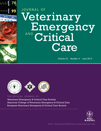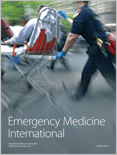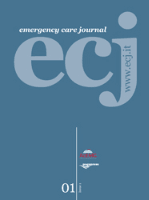
BMC EMERGENCY MEDICINE
Scope & Guideline
Leading the way in emergency medicine scholarship.
Introduction
Aims and Scopes
- Emergency Medical Services (EMS) and Prehospital Care:
Research focused on the practices, challenges, and innovations in emergency medical services, including prehospital assessments, care protocols, and the roles of EMS personnel. - Trauma Care and Management:
Studies addressing the management of traumatic injuries, including prediction models for outcomes, trauma triage, and interventions to improve care in trauma settings. - Emergency Department (ED) Operations and Management:
Investigations into the efficiency and effectiveness of emergency department practices, including crowding, patient flow, triage systems, and the impact of organizational changes. - Clinical Guidelines and Protocols:
Research evaluating the implementation and outcomes of clinical guidelines and protocols in emergency medicine, including medication use, procedural interventions, and patient safety measures. - Disaster and Crisis Management:
Studies focusing on preparedness, response, and recovery strategies in emergency situations, including public health emergencies, natural disasters, and mass casualty events. - Innovations in Emergency Medicine:
Exploration of new technologies, methodologies, and training programs aimed at improving emergency care delivery, such as telemedicine, simulation training, and novel therapeutic approaches. - Patient-Centric Research:
Research focusing on patient experiences, satisfaction, and outcomes in emergency care settings, including studies on vulnerable populations and healthcare disparities.
Trending and Emerging
- Telemedicine and Remote Care:
There is a significant increase in research focused on the integration of telemedicine within emergency care, especially highlighted by the COVID-19 pandemic. This includes studies on remote patient monitoring, virtual consultations, and the efficacy of tele-triage systems. - Machine Learning and Predictive Analytics:
The use of machine learning and predictive analytics to improve patient outcomes and operational efficiency in emergency departments is gaining traction. Researchers are exploring algorithms that can predict patient severity, outcomes, and resource needs. - Mental Health and Emergency Care:
Emerging studies are increasingly addressing the mental health aspects of emergency care, including the management of psychiatric emergencies and the psychological impact of emergency situations on both patients and providers. - Personal Protective Equipment (PPE) and Infection Control:
Research related to PPE usage and infection control measures has surged, particularly in the context of the COVID-19 pandemic, emphasizing the importance of safety protocols for healthcare workers and patients. - Patient Flow and ED Optimization:
There is a growing focus on studies aimed at optimizing patient flow within emergency departments, including the evaluation of triage systems and interventions designed to reduce wait times and improve care delivery. - Community Paramedicine and Alternative Care Models:
Emerging themes include the role of community paramedics and alternative care models that aim to address non-emergency needs, reducing unnecessary ED visits and improving access to care.
Declining or Waning
- Traditional Emergency Medicine Practices:
There appears to be a decreasing emphasis on conventional practices in emergency medicine that do not incorporate innovative or evidence-based approaches, as the field increasingly moves towards more data-driven and technology-enhanced methodologies. - Static Protocols for Patient Care:
Research on static protocols that do not account for the dynamic nature of emergency medicine is becoming less prevalent. There is a growing recognition of the need for adaptable and flexible guidelines that can respond to varying patient needs and situations. - General Emergency Medical Training:
While foundational training remains crucial, there is less focus on generalized emergency training programs. More attention is shifting towards specialized training that addresses specific emergencies, such as trauma or pediatrics. - Single-Center Studies:
The trend of single-center studies is declining in favor of multicenter collaborations that provide broader data and insights. This shift is likely due to a desire for more generalizable findings across diverse populations and healthcare systems. - Basic Life Support (BLS) Studies:
Research focused exclusively on basic life support techniques is waning as the field emphasizes advanced life support and comprehensive emergency care strategies that incorporate a wide range of clinical skills.
Similar Journals

Clinical and Experimental Emergency Medicine
Advancing emergency care through innovative research.Clinical and Experimental Emergency Medicine, published by the SEOUL KOREAN SOCIETY OF EMERGENCY MEDICINE, is a premier Open Access journal dedicated to advancing knowledge and practice within the fields of emergency medicine and emergency nursing. With an ISSN of 2383-4625 and an E-ISSN of 2383-4625, this journal has established itself prominently in the academic community, achieving a notable Q2 ranking in both Emergency Medicine and Emergency Nursing categories in 2023. The journal is committed to providing highly relevant research, innovative clinical practices, and educational resources that address the urgent and evolving challenges in emergency care. With a vision to foster collaboration among researchers, practitioners, and students, it aims to contribute significantly to the body of knowledge that enhances emergency medical services and improves patient outcomes globally. Accepting submissions and offering Open Access since its inception in 2014, the journal is positioned as a key resource for those dedicated to the advancement of emergency medicine.

EMERGENCY MEDICINE JOURNAL
Enhancing Emergency Medicine Through Open Access KnowledgeEmergency Medicine Journal, published by BMJ Publishing Group in the United Kingdom, stands as a preeminent resource within the realm of emergency and critical care medicine. ISSN 1472-0205 and E-ISSN 1472-0213 reflect its commitment to accessible research, emphasizing open access options to enhance the dissemination of vital medical insights. The journal boasts an impressive categorization, achieving a Q1 ranking in Critical Care and Intensive Care Medicine, Emergency Medicine, and miscellaneous Medicine in 2023. With a focus on high-quality peer-reviewed articles, it serves as an essential platform for sharing innovative research and evidence-based practices that enhance patient care in emergency settings. Ranking 23rd in Emergency Medicine, with a commendable 79th percentile in Scopus rankings, it underscores its position as a leading journal among peers, making it indispensable reading for researchers, professionals, and students alike who seek to stay abreast of evolving trends and practices in emergency medicine and critical care.

JOURNAL OF VETERINARY EMERGENCY AND CRITICAL CARE
Empowering practitioners through cutting-edge research.JOURNAL OF VETERINARY EMERGENCY AND CRITICAL CARE, published by WILEY, is a leading journal in the field of veterinary science, specifically focusing on emergency medicine and critical care for animals. With an impact factor that underscores its significance in the field, this journal serves as a crucial resource for veterinary professionals, researchers, and students dedicated to advancing the care of animals in critical conditions. Since its inception in 1991, the journal has continually contributed to the knowledge base and methodological advancements in veterinary emergency practices, consistently ranking in the Q1 category for veterinary sciences, as per the latest Scopus Ranks. Located in the United Kingdom, the journal is committed to disseminating high-quality, peer-reviewed research that addresses the challenges and innovations in veterinary critical care. With its goal to enhance clinical outcomes through evidence-based practices, the JOURNAL OF VETERINARY EMERGENCY AND CRITICAL CARE remains an essential platform for scholarly communication and collaboration in veterinary medicine.

Eurasian Journal of Emergency Medicine
Pioneering research for contemporary emergency care.Eurasian Journal of Emergency Medicine is a premier journal dedicated to advancing the field of emergency medicine. Published by GALENOS PUBL HOUSE, this renowned open-access journal has been at the forefront of disseminating critical research and innovative practices since its inception in 2003. With an ISSN of 2149-5807 and an E-ISSN of 2149-6048, it provides a platform for researchers, professionals, and students to share their findings and enhance their understanding of emergency medical practices. The journal's commitment to open access ensures that vital knowledge and research are available to a global audience, promoting collaboration and development within the field. As a valuable resource, the Eurasian Journal of Emergency Medicine plays a pivotal role in shaping contemporary emergency care, addressing pressing issues, and exploring advancements that benefit practitioners and patients alike.

Emergency Medicine International
Connecting global research to improve emergency healthcare outcomes.Emergency Medicine International is a distinguished journal dedicated to the dynamic field of emergency medicine, published by HINDAWI LTD. As an Open Access journal since 2010, it ensures widespread dissemination of high-quality research, providing vital insights and advancements in emergency care and crisis intervention methodologies. With an ISSN of 2090-2840 and an E-ISSN of 2090-2859, the journal is indexed in Scopus, where it holds a commendable rank of #104 of 109 in the emergency medicine category, placing it in the 5th percentile. Spanning crucial years from 2014 to 2017 and 2022 to 2024, Emergency Medicine International has established a reputation for publishing significant findings that aid practitioners and researchers in improving emergency healthcare outcomes. Operating from its headquarters in Egypt, the journal serves as an essential resource for professionals and students alike, fostering the development of evidence-based practice in a critical area of healthcare.

Prehospital and Disaster Medicine
Shaping the Future of Emergency ResponsePrehospital and Disaster Medicine is a leading peer-reviewed journal published by Cambridge University Press that targets the ever-evolving fields of emergency medicine and disaster management. With an ISSN of 1049-023X and an E-ISSN of 1945-1938, this journal has established its significance within the academic community since its inception, with coverage extending from 1985 to the present. It is widely recognized within its category as evidenced by its 2023 rankings, which position it in the Q2 quartile for both Emergency Medicine and Emergency Nursing. The journal boasts impressive Scopus rankings, standing at Rank #7/32 in Emergency Nursing and Rank #31/109 in Emergency Medicine, demonstrating its relevance and impact in these critical areas. Although it does not offer Open Access, Prehospital and Disaster Medicine is committed to disseminating vital research and innovative practices that address prehospital care, disaster response, and the intersection of these fields, serving as an essential resource for researchers, professionals, and students alike.

Emergency Care Journal
Catalyzing Change in Critical Care with Every PublicationThe Emergency Care Journal is a vital open-access publication dedicated to the field of emergency medical services and nursing, published by PAGEPRESS PUBL. Since its inception in 2005, the journal has aimed to provide a platform for researchers, clinicians, and scholars to share knowledge and advance practices in the critical domain of emergency care. With an ISSN of 1826-9826 and an E-ISSN of 2282-2054, the journal is committed to enhancing accessibility and reaching a global audience. Although its Scopus rankings reflect a competitive landscape, particularly in the ranks of Health Professions and Emergency Medicine, the journal continues to serve as an essential resource for emerging studies and professional insights. Nestled in Italy, the journal seeks to bridge the gap between academic research and real-world application, ultimately improving patient care and outcomes in emergency settings. As it converges into the years 2023 and 2024, Emergency Care Journal stands poised to foster scholarly discussions and innovative research that are crucial to the evolving landscape of emergency medicine.

Open Access Emergency Medicine
Exploring vital advancements in emergency health services.Open Access Emergency Medicine, published by DOVE MEDICAL PRESS LTD, is a premier journal dedicated to the dynamic fields of Emergency Medicine and Emergency Nursing. With its ISSN 1179-1500, this journal has established a notable presence since its inception as an Open Access platform in 2010, offering unrestricted access to high-quality research and innovative practices in the area. As one of the leading journals in its field, it holds a respectable Q2 ranking in both Emergency Medicine and Emergency Nursing categories as of 2023, reflecting its commitment to advancing knowledge and fostering impactful research. The journal is indexed in prestigious databases with solid Scopus rankings, placing it in the 65th percentile for Emergency Medicine and the 64th percentile for Emergency Nursing, ensuring that contributions reach a diverse audience of researchers, practitioners, and students worldwide. With its focus on contemporary issues, this journal serves as an essential resource for the continual growth and development of emergency health services.

European Journal of Trauma and Emergency Surgery
Transforming Trauma Care with Scholarly ExcellenceThe European Journal of Trauma and Emergency Surgery, published by SPRINGER HEIDELBERG, stands as a pivotal resource in the field of trauma and emergency medicine. With an ISSN of 1863-9933 and E-ISSN 1863-9941, this esteemed journal has been disseminating vital research since its inception in 2007, with ongoing contributions expected through 2024. It holds a reputable impact factor substantiated by its placement in the Q2 category across multiple disciplines, including Critical Care and Intensive Care Medicine, Emergency Medicine, Orthopedics and Sports Medicine, and Surgery. This distinction highlights the journal's commitment to high-quality, impactful research, as reflected in its notable Scopus rankings that place it within the top percentiles of its respective fields. Researchers, professionals, and students will find a wealth of scholarly articles that provide insights into contemporary practices and innovations, reinforcing the journal's role as a vital conduit for knowledge and advancements in trauma and surgical care.

Current Emergency and Hospital Medicine Reports
Bridging Research and Practice in Emergency MedicineCurrent Emergency and Hospital Medicine Reports, published by Springer, is a pivotal journal in the field of emergency and hospital medicine. With a commitment to disseminating crucial research and advancements, this journal serves as a platform for sharing high-quality studies that enhance clinical practices and improve patient outcomes. As an important resource for researchers, healthcare professionals, and students, it caters to the growing need for evidence-based knowledge in emergency medicine. Although currently not classified as open access, the journal offers a wealth of information that aligns with the latest innovations and practices in the discipline. By engaging with diverse topics, from clinical interventions to hospital management strategies, it aims to inform and inspire the next generation of practitioners and scholars in this vital field of medicine. With its ISSN of 2167-4884, Current Emergency and Hospital Medicine Reports is dedicated to advancing the frontiers of emergency healthcare through rigorous research and illuminating insights.